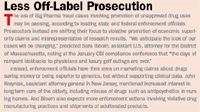When Talk is Not So Cheap
Pharmaceutical Executive
FDA and industry are pushing user fees, while they struggle with curbs on communications.
Hearings last month before the House Energy & Commerce health subcommittee provided a forum for the opening salvos in the user fees renewal campaign needed to keep the FDA going. Commissioner Margaret Hamburg made the case for renewing the Prescription Drug User Fee Act (PDUFA V) and legislation to spur pediatric drug labeling; Janet Woodcock, director of the Center for Drug Evaluation and Research (CDER), explained the importance of new fees for generic drugs and biosimilars; and Jeffrey Shuren, director of the Center for Devices and Radiological Health (CDRH), outlined a hard-fought agreement on the medical device user fee program (MDUFA).

Jill Wechsler
Marketers, providers, and FDA leaders want to enact a user fee bill by summer, but the legislators indicated they have pet issues to tag onto this must-pass legislation. The most likely addition is a measure enhancing FDA controls over the global drug supply chain, including stiffer import controls, more inspections of foreign operators and (most likely) wider manufacturer notification about looming drug shortages. Both Democrats and Republicans want to boost foreign inspections to level the playing field for U.S. firms, and new user fees for generic drugs provide needed funding for these activities.
More contentious is whether to loosen conflict-of-interest (COI) requirements for advisory committee members that Republicans say are too stringent and can delay new drug approvals. Orphan drug advocates similarly claim that stiffer restrictions on FDA advisors keep out key scientists in specialized research fields. However, commissioner Hamburg said that the current COI policy and waiver caps are not a problem, and that the issue doesn't need a "legislative fix." That was a shift from her testimony last year that the COI rules made it difficult to find sufficiently qualified individuals to serve on advisory panels.
There was debate over proposed changes to the Best Pharmaceuticals for Children Act (BPCA) and the Pediatric Research Equity Act (PREA), which both offer incentives for manufacturers to study the safety and efficacy of drugs for children and are up for five-year renewals as part of the PDUFA process. The programs enjoy strong support from health professionals, researchers, and pharma companies, but a number of reform proposals have surfaced.
Industry opposes any reduction in the extra six months' exclusivity given for doing requested pediatric studies, as well as new penalties for failing to complete requested studies on schedule. But there's support for FDA to be able to levy fines on companies that miss deadlines. The American Academy of Pediatrics (AAP) also wants pharma companies to submit pediatric study plans at the end of Phase II, instead of waiting until application submission, and to include neonates in more studies. Researchers and sponsors agree that PREA requirements for pediatric studies should be made permanent, but the docs support the Democratic position that the exclusivity provisions authorized by the BPCA should continue to be re-evaluated every five years.
In addition to providing more information on therapies for children, PDUFA may contain new proposals to spur development of critical therapies, including antibiotics to combat drug resistance and treatments for rare conditions. There's bipartisan backing for the "Sprint Act" (Spending Reductions through Innovations in Therapies), which would provide $50 million to fund public/private partnerships doing research on critical conditions like Alzheimer's disease. However, FDA and sponsors are leery of measures that prevent the agency from seeking necessary clinical data to approve a new drug, as sought by smaller biotech firms and patient groups clamoring for more certainty in the approval process.
Complaints about the proliferation of Risk Evaluation and Mitigation Strategies (REMS) may be off the table due to FDA efforts to scale back that program. But there may be some sparring over revising FDA's mission statement to highlight its role in creating jobs and economic growth. Hamburg noted at the Energy & Commerce hearing that FDA would have trouble factoring jobs creation into decisions on new product approvals. "It will get very, very complicated and, frankly," she said, "I think it would be quite inappropriate."
Old Standards for New IT
In addition to lobbying for PDUFA, pharma companies are anxious to gain clarity from FDA on how its rules on drug marketing and promotion can fit the age of instant Internet communications and unfettered public access to information previously limited to health professionals. Although much of the world now uses the Internet to communicate with friends and relatives, to market goods and services, and to announce important developments around the globe, pharmaceutical marketers are stuck in regulatory limbo due to curbs on what they can tell the public about their products and operations.
After extensive discussion of social media uses and formats, FDA's Office of Prescription Drug Promotion (OPDP) within CDER now plans to develop several guidances on "concepts that have long-term applicability," said Jean-Ah Kang, OPDP assistant to the director, at CBI's January Pharmaceutical Compliance conference in Washington, D.C. Instead of issuing platform-dependent policies that would apply to posting information on, say, Twitter or YouTube, which could become outdated quickly by changing technology, the agency is looking to address broader Internet communications issues. These include messages with space limitations as found in banner ads or social media listings; manufacturer accountability for online communications; links to Internet websites; correcting misinformation on third-party websites; and how to notify FDA of a real-time communications activity.
Social Media Unfriendly to Pharma?
FDA also is addressing social media use through guidance on other marketing practices, as in its December 2011 draft guidance on how pharma marketers should respond to unsolicited requests for off-label information. In distinguishing "unsolicited" from "solicited" queries, FDA notes that questions spurred by a company video posted on YouTube, for example, would shift the question into the "solicited" category, which may be a violation. Social media sites also are mentioned as possible forums for a company to receive questions from the public, including those involving off-label drug uses.

Less Off-Label Prosecution
Most contentious is FDA's proposal that manufacturers handle requests for information made in public or via the Internet the same as queries made in writing, by email or the phone: provide a response only to the individual requester in "a private, one-on-one communication"—and not online. The agency's concern is that a public response exposes those not making the query to off-label information, and that such messages could remain on a website after they become outdated. When receiving an unsolicited request on an issue related to off-label use, FDA advises companies to provide contact information to medical or scientific personnel (not salesmen) and direct the individual to follow up off-line. However, this means that a broad audience can see a query and any resulting independent statements, which could be erroneous, but not the company's answer.
Such communications restrictions raise concerns about broader limits on industry use of modern IT for a broad range of corporate and operational functions, such as reporting corporate news and developments, recruiting patients for clinical trials, or operating hotlines to receive consumer questions and comments. A hot topic is utilizing social media to expand public reporting of adverse drug events. Pharma companies are leery of having to scour Twitter and Facebook to identify such reports and respond to them, which could be a monumental task. But the larger problem is that manufacturers still could be constrained from addressing misleading AER reports, particularly if they touch on off-label use.
Additional guidance on pharma use of social media to communicate information may take some time because OPDP is under pressure to develop policies on a number of drug marketing topics. The agency checked off one item by publishing draft guidance in January on product name placement, updating a 1999 policy. A top priority on its to-do list is to implement a program established in 2007 for providing timely pre-review advice on direct-to-consumer TV ads. And work continues on the seemingly endless task of revising the "brief summary," now likely part of a larger effort to establish a common format for multiple patient information documents.
Jill Wechsler is Pharmaceutical Executive's Washington correspondent. She can be reached at jwechsler@advanstar.com

Navigating Distrust: Pharma in the Age of Social Media
February 18th 2025Ian Baer, Founder and CEO of Sooth, discusses how the growing distrust in social media will impact industry marketing strategies and the relationships between pharmaceutical companies and the patients they aim to serve. He also explains dark social, how to combat misinformation, closing the trust gap, and more.
Is Artificial Intelligence a ‘Product’? Products Liability Implications for AI-Based Products
April 10th 2025As the physical products we use evolve to become increasingly complex, traditional products liability frameworks may not always fit to provide remedies for harm that can result from using novel product types.
FDA Approves Opdivo Plus Yervoy Regimen for MSI-H/dMMR Colorectal Cancer
April 9th 2025Approval of the Opdivo plus Yervoy combination regimen was based on results from the Phase III CheckMate-8HW trial, which was the largest immunotherapy study in patients with previously untreated, unresectable, or metastatic microsatellite instability-high or mismatch repair deficient colorectal cancer.